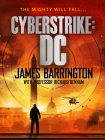Cyberstrike, James Barrington [short story to read .TXT] 📗

- Author: James Barrington
Book online «Cyberstrike, James Barrington [short story to read .TXT] 📗». Author James Barrington
It had taken them another hour to travel along the Thames to the almost derelict boathouse that they had discovered during their initial surveillance, and where the cabin cruiser would remain while they prepared it for its short final voyage. That didn’t take too long, because while the search for a suitable boat had been underway, the remaining two members of the gang had been sourcing the other components that they would need, principally ammonium nitrate fertiliser.
This they couldn’t buy in the quantities they needed because that would attract unwelcome attention to them, but by visiting a number of farms located to the west and north-west of London they had been able to steal bags of the substance, taking just two or three from each farm they visited after dark, reasoning that most farmers wouldn’t notice that the fifty-four bags of fertiliser they had owned on Wednesday had become fifty-one or fifty-two bags by Thursday.
Ammonium nitrate is a high-nitrogen fertiliser and is comparatively stable in most circumstances – warehouses in Beirut excluded, obviously – and when mixed with diesel oil in the ratio of about 94 per cent ammonium nitrate to 6 per cent diesel fuel it forms a compound known as ANFO, four letters which rather unimaginatively stand for ‘ammonium nitrate fuel oil’, which is more stable than ammonium nitrate by itself and is classed as a tertiary explosive, meaning that it can’t be detonated by shock or something like a blasting cap. To cook off ANFO a secondary explosive known as a booster or a primer has to be used. The explosive yield of the mixture can be improved by as much as 30 per cent by the addition of about 15 per cent powdered aluminium by weight.
Tariq and his companions had already sourced the aluminium powder and Abū Tadmir, the name adopted by Mahdi Sadir, the leader of their group but a man who was not literally a part of it, had had both the funds and more importantly the contacts to produce a half-kilo block of Semtex and a detonator which together would act as the booster for the ANFO. He had also, at one of their meetings held at random locations outside London, supplied a long canvas bag, the contents of which had clanked mechanically when he handed it over.
That, Sadir had said in reply to the obvious question from Tariq, was their insurance policy. He’d opened the bag and produced a Kalashnikov AK-47 assault rifle, a box of ammunition and two spare magazines.
‘This,’ he’d said, ‘will ensure that the boat will not be stopped on the river by anybody.’
Ten days after they’d stolen the cabin cruiser, it was ready. The very first thing they’d done was to change the name painted on the stern to try to disguise the fact that it had been stolen. That was easy because the original name was made up of six letters and was a palindrome, and by painting over the first and last they’d produced a name that was still a palindrome but quite different to the original.
Then they’d stripped out virtually everything from the interior of the saloon and dumped it. There wasn’t much finesse involved in the removal, though they took great care to make sure that the hull wasn’t damaged by their actions. Acting on Sadir’s specific instructions, they’d then packed all the ANFO into watertight bags and stacked them on the floor of the saloon in a single thick layer wrapped in heavy-duty waterproof plastic sheeting and sealed with copious amounts of tape. Both ammonium nitrate and ANFO were highly hygroscopic and it was essential to keep the mixture as dry as possible to maximise its explosive power.
More or less in the centre of the improvised explosive was the chunk of Semtex into which the electrically powered detonator had been inserted, attached to a simple circuit that included a battery. That would form the booster that would initiate the explosion.
They had known from the start that the mission would require sacrifice because Sadir had made it very clear that the only way it was going to work was if they were directly involved in the delivery of the improvised weapon. And by that he meant one of them would have to stand in the cabin cruiser beside the explosive, steer the vessel to its destination and then trigger the booster charge when the boat was in precisely the optimum position.
That was the reality of the situation. They did not have the technology to even attempt to control the boat remotely, and the strong currents and powerful tidal flow along the Thames meant that any remote-control system would be cumbersome and probably unworkable.
The second relevant factor was timing, and the same argument applied. This was not something that could be initiated remotely. Only a man actually on board the vessel would know when both the time and the position were right, and at that point he would initiate the detonation.
So martyrdom was a given, but that was not a problem. All the members of the group were utterly committed and perfectly prepared to die for their beliefs. They knew beyond any doubt that dying as a martyr was an absolute guarantee that they would enjoy an eternity of paradise in the afterlife.
But that wasn’t all. Because of the importance of the operation to Sadir and, more significantly, to his comrades and the elders back in Iraq who were funding it, he had decided that there needed to be two men on the boat. One would have to steer it, to get it into the correct position, and the second one would act as a guard and protect the vessel in the event that it was detected and an attempt made to stop it or board it.
And, though Sadir did not labour the point and none





Comments (0)